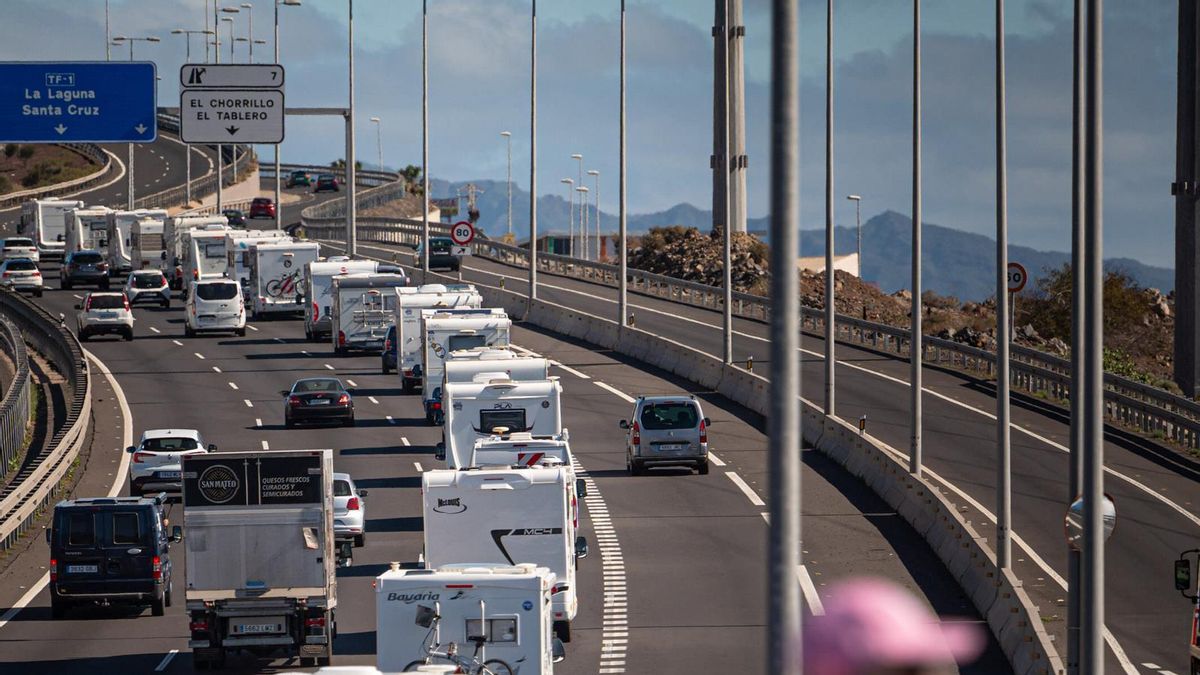Around 350 vehicles traversed Tenerife from the south to the capital on Saturday, February 22 of this year –in a convoy, quite literally– to demand that “the law is upheld” and that owners of these wheeled homes be allowed to park “without being persecuted by the authorities,” as they have become a way of life for many.
The caravan enthusiasts from Tenerife, predominantly based in the southern municipalities, lament that “we are treated as if we were criminals.” More than six months later, the situation remains largely unchanged. There is still no clear regulation and a legal grey area for a community comprising about 5,000 enthusiasts here, plus an average of 10,000 visitors coming from the mainland each year.
The authoritative voice of Juan Martín, president of the Association of Certified Motorhomes and Campers of the Canary Islands (Acat), outlines the current state of a seemingly entrenched conflict. “There is a lack of clear regulation,” he notes at the outset, as “what little is done is at the municipal level and each council sets its own rules without consulting the associations, or at least not our predominant one.”
As Legal as Any Other Vehicle
These vehicles are as legal as any other that pays road tax and has the right to move and park. Martín acknowledges that “not all locations may be suitable, whether due to their location or limited spaces constrained by the larger size of caravans or motorhomes.”
He emphasises: “The DGT (General Directorate of Traffic) and the General Traffic Regulation state that as long as a vehicle, including ours, is parked correctly without exceeding the line markings or time limitations, if any, it is irrelevant whether its occupants are inside.” It is prohibited to deploy any items that extend beyond the vehicle’s perimeter such as clotheslines, awnings, levelling devices—unless they are for safety—or stabilising supports, etc.
The president of the motorhome community points out that “in areas designated only for cars, it can be difficult to park a medium-sized motorhome.” He further notes, “There are even places where they have narrowed the zone so that we cannot park because we exceed the line.” He summarises: “As is often the case, it is clear that the prohibition comes before the solution to the problem.”
Accusations
Juan Martín defends himself against vague accusations, such as that they litter or might start a fire for a barbecue and cause a blaze: “If someone does this, they should be fined as appropriate, but we cannot criminalise and discriminate against an entire community based on the assumption that some of its members will commit an infraction.”
The president of Acat is adamant that “the regulation makes it clear that excluding certain users from public thoroughfares must be based on objective reasons, never subjective ones. We advise our members to be respectful of the rules and signage. The abuse by some leads to restrictions for all.”
There were worse moments regarding prohibitions on overnight stays and parking, when “just stopping would incur their wrath. That attitude has softened a bit, though not everywhere.” He believes this is due to “the economic downturn that has affected businesses in the areas we usually visit, which is a concern.”
A Way of Life
Motorhoming in the island is thriving in terms of the number of participants, both residents and visitors, particularly from the mainland. The two ferry companies operating to Tenerife report figures of between 6,000 and 7,000 vehicles each year. On the island, there may be around 5,000 registered vehicles, in addition to those who engage in caravanning independently. “It’s a way of life like any other,” summarises Martín, explaining that “I choose the lifestyle of having a home on wheels because I have the freedom to go where I deem fit, as long as I comply with current legislation and road safety regulations.”
Regarding the Cabildo‘s plan for parking areas and services, he mentions, “We have discussed this and held meetings.” He clarifies that the proposal is for “recreational areas in general, not specifically for motorhomes.” He refers to the public infrastructures on the island for this segment: “It’s curious that the Cabildo’s campsite at La Tejita, in El Médano, remains closed without us fully understanding why. The one at Punta del Hidalgo, in La Laguna, is also closed, although it is set to reopen soon.” On the island, the only active campsite for caravans is the private Nauta site. “That is our current map,” he concludes.
Juan Martín assesses from his extensive experience that “the future does not look promising, simply because we are not being listened to when, I repeat, we are a solution and not a problem.” He insists that “motorhoming is here to stay.” He concludes: “Our community continues to grow, and it is deeply frustrating that we are all lumped together because that is called stigmatisation, discrimination, and belittlement.”














